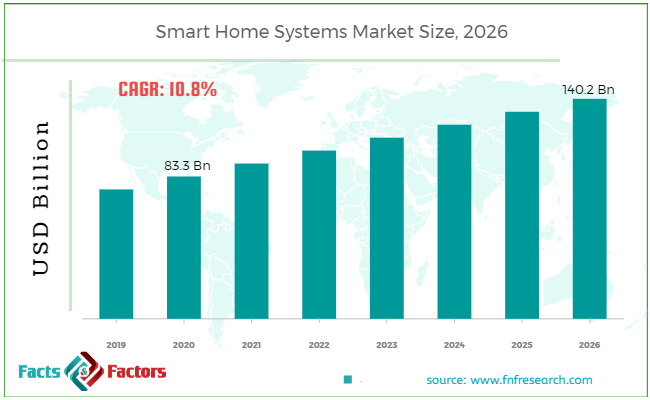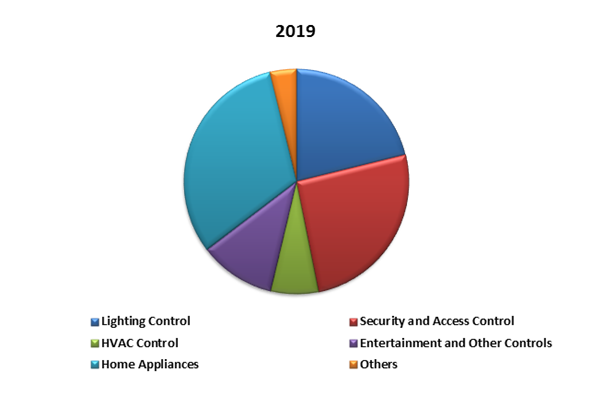Search Market Research Report
Smart Home Systems Market Size, Share Global Analysis Report, 2021 – 2026

Smart Home Systems Market By Technology (Cellular Network Technologies, Protocols & Standards, Wireless Communication Technologies), By Product (Lighting Control, Security & Access Control, HVAC Control, Media & Entertainment & Others), And By Regions - Global & Regional Industry Perspective, Comprehensive Analysis, and Forecast 2021 – 2026
Industry Insights
The latest findings and offers on the smart home's systems market were published by Facts & Factors in a neatly titled “Global Smart Home Systems Market” report. At Facts & Factors, we estimated the global smart home systems market to be valued at USD 83.3 Billion in the year 2020; with growth at a CAGR rate of 10.8% is expected to attain an overall value of USD 140.2 Billion by 2026.

 Key Insights from Primary Research
Key Insights from Primary Research
- As per our primary respondents, the global smart home systems market is estimated to grow over the forecasted period, recording a CAGR of approximately 13%.
- From our primary research, we gathered the insights that the rise in the adoption of monitoring systems for light monitoring, HVAC monitoring, security and authentication applications, etc. has been a key factor that has augmented the market across the globe.
- Our primary interviewees predicted that the the Asia-Pacific region is expected to dominate the global smart home systems market, due to the rising real estate market in developing countries such as India, China, etc. and growing urbanization.
- Based on system, the home appliances market dominated the global smart home systems market in 2019, recording a market share of approximately 30%. The home appliances market is estimated to grow at a CAGR of nearly 12% till 2026.
- On the basis of region, India smart home systems market accounted for a share of around 10% in 2019 and is anticipated to record a CAGR of nearly 13% over the forecasted period due to rising demand for security and authentication systems and lightening control systems from consumers.
 Key Recommendations from Analysts
Key Recommendations from Analysts
- As per our analysts, the global smart home systems market is predicted to reach a market value of nearly USD 220 billion in 2026 from a value of USD 85 billion in 2019.
- Changing consumer preferences has been a key factor that influenced consumers to take necessary security measure to avoid unauthorized access and reduce threats related to thefts, which has led to an increase in the demand for security surveillance systems.
- Moreover, with rise in demand for smart home systems, the demand for integration of such products with other smart products is anticipated to create new revenue generating avenues in the global smart home systems market for companies planning to enter the integration services market.
- Our analysts predict also estimate that Australia smart home systems is expected to reach a market value of approximately USD 9 billion till 2026, recording a CAGR of around 11%.
- According to our analysts, on the basis of systems, the entertainment and other controls smart home systems market is probable to record the fastest growth among all other segments and is predicted to reach a market value of around USD 30 billion till 2026. Changing lifestyle has influenced consumers to spend more on customized entertainment solutions, which is a growth fueling factor for the entertainment and other controls smart home systems market.
 The Global Smart Home Systems Market Share – By System
The Global Smart Home Systems Market Share – By System

Smart homes or home automation involves the process of interconnecting a wider range of devices that function with the association of the Internet in order to organize and regulate several home appliances and systems. They are often deemed as an advanced form of technology that is often used for making home appliances extremely effective and energy-saving. Smart home systems offer comfort, security, and convenience to the user.
The global smart homes systems market is expected to be driven toward a higher market share owing to the rising need for energy-saving demands coupled with the rising adoption of smart devices to name a few. Additionally, factors pertaining to low carbon emission-oriented solutions coupled with rising demand from remote locations in terms of monitoring measures are expected to increase the footprint of the global smart homes systems market during the forecast period. Moreover, increasing disposable income among consumers coupled with the rising urge of people to live in high-end and luxurious homes is expected to boost the global smart homes systems market during the forecast duration.
The global smart homes systems market is expected to be driven by factors pertaining to increased functionality in terms of dimming and closing lights and curtains, automatically lighting up exit routes, regulating security cameras and utility meters to name a few. Additionally, the rising adoption of smartphones and rising connectivity measures are expected to fuel the global smart homes systems market during the forecast period. However, the higher cost of switching to smart device consumers is expected to decrease the market share for the global smart homes systems market during the forecast period.
The global smart homes systems market is segmented into technology, product, and region.
The global smart homes systems market is divided into cellular network technologies, protocols & standards, and wireless communication technologies on the basis of technology. The wireless communication technologies segment is expected to witness the largest and the fastest-growing CAGR during the advent of the forecast owing to a less invasive setup coupled with lower setup costs to name a few. Additionally, increasing convenience measures coupled with the rising adoption of wireless-based communications measures are expected to cement the latter’s position during the advent of the forecast.
The global smart homes systems market is divided into lighting control, security and access control, HVAC control, media & entertainment, and others on the basis of product. The security and access control category is expected to witness the largest market share during the advent of the forecast owing to increased adoption of the internet of things (IoT) and the integrated controls for a variety of functions to name a few. Moreover, increased functionality of such solutions in the consumer’s smartphones coupled with system scalability and easy extension measures is expected to cement the segment’s position during the forecast period.
 Reports Scope
Reports Scope
Report Attribute |
Details |
Market Size in 2020 |
USD 83.3 Billion |
Projected Market Size in 2026 |
USD 140.2 Billion |
CAGR Growth Rate |
10.8% CAGR |
Base Year |
2020 |
Forecast Years |
2021-2026 |
Key Market Players |
ABB Ltd, Control4 Corporation, Crestron Electronics, Inc., Honeywell International, Inc., Ingersoll-Rand plc., Johnson Controls, and Others |
Key Segments |
Technology, Products, and Region |
Major Regions Covered |
North America, Europe, Asia Pacific, Latin America, and Middle East & Africa |
Purchase Options |
Request customized purchase options to meet your research needs. Explore purchase options |
North America is expected to witness the largest market share during the advent of the forecast owing to a well-established manufacturer's overview coupled with an ever-increasing consumer base to name a few. Additionally, the region is home to increased adoption of cellular-based communication coupled with increasing disposable income among consumers is expected to increase the footprint of the smart homes systems market during the forecast period.
Asia-Pacific is expected to occupy a substantial market share during the advent of the forecast owing to the region is the home to several macroeconomic stimulus conditions coupled with the rising adoption of innovative technologies. The growing geriatric population coupled with rising investment opportunities is further expected to boost the smart homes systems market during the advent of the forecast.
 Some of the leading players in the global market include
Some of the leading players in the global market include
- ABB Ltd
- Control4 Corporation
- Crestron Electronics Inc.
- Honeywell International Inc.
- Ingersoll-Rand plc.
- Johnson Controls
- Legrand SA
- Leviton Manufacturing Company Inc.
- Lutron Electronics Co.Inc.
- Schneider Electric
- Siemens AG
- ADT
- Robert Bosch
- Delta Controls
 By Technology Segment Analysis
By Technology Segment Analysis
- Cellular Network Technologies
- Protocols & Standards
- Wireless Communication Technologies
 By Product Segment Analysis
By Product Segment Analysis
- Lighting Control
- Security & Access Control
- HVAC Control
- Media & Entertainment
- Others
 By Regional Segment Analysis
By Regional Segment Analysis
- North America
- U.S.
- Canada
- Europe
- UK
- France
- Germany
- Italy
- Spain
- Rest of Europe
- Asia Pacific
- China
- Japan
- India
- South Korea
- Southeast Asia
- Rest of Asia Pacific
- Latin America
- Brazil
- Mexico
- Rest of Latin America
- Middle East and Africa
- GCC Countries
- South Africa
- Rest of MEA
Industry Major Market Players
- ABB Ltd
- Control4 Corporation
- Crestron Electronics Inc.
- Honeywell International Inc.
- Ingersoll-Rand plc.
- Johnson Controls
- Legrand SA
- Leviton Manufacturing Company Inc.
- Lutron Electronics Co.Inc.
- Schneider Electric
- Siemens AG
- ADT
- Robert Bosch
- Delta Controls
Frequently Asked Questions

Copyright © 2025 - 2026, All Rights Reserved, Facts and Factors


